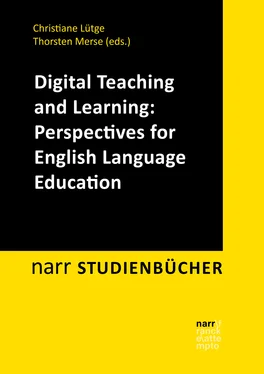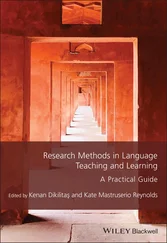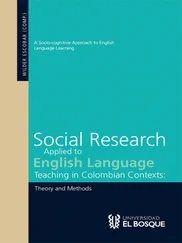facilitating learners’ digital competenceThe last area can be understood as the culmination of all previous competence domains of educators, when teachers apply their digital know-how to fostering the digital competence of learners (Redecker 2017: 23; 77–87). Within this shift of focus to learners, teachers receive a central role in view of the following five sub-dimensions:
Information and media literacy: Teachers encourage learners to articulate a concrete information need, then proceed to searching, organizing, storing and analyzing new information, and finally, to evaluate the credibility and reliability of information and its sources. For language learning, learners could work with an online language databank such as the British National Corpus to research collocations. For cultural and global learning, learners could collate different opinions and perspectives on a sustainability issue such as palm oil production.
Digital communication and collaboration : Here, teachers prepare tasks that require learners to use digital technologies for communication, collaboration and civic participation effectively and responsibly, including, for example, the co-construction of knowledge, awareness of behavioral norms in online worlds, and understanding appropriate digital communication means. For example, learners could design a webinar with an author of the book they are reading, moving from the invitation via e-mail, to the joint collection of suitable questions, to welcoming the guest and hosting the event via a video-conferencing tool such as Zoom.
Digital content creation: Within this dimension, teachers encourage learners to create learning outcomes and products in digital ways, e.g. by using presentation technologies such as Prezi, or by handing in a working result as a video. The issue of knowing copyright and licensing rules is covered here, too.
Responsible use: Here, teachers aim at equipping learners with a positive attitude towards digital technologies and ensuring that learners know how to manage their physical, psychological and social well-being, e.g. in view of privacy issues, sharing personal information on social media platforms, or protection from cyberbullying. Such concerns could be turned into relevant project work in which learners move from gaining knowledge of an issue to concrete implementations.
Problem-solving: Within this dimension, teachers invest continuous efforts to help learners identify and solve technical problems, update their digital competence with regard to new arrivals in the technological and digital world, or transfer available knowledge to new situations. For foreign language education, it makes sense to negotiate and perform such tasks in the foreign language through providing appropriate language (e.g. ‘My device is not working properly.’ – ‘Maybe the batteries need recharging?’ – ‘Oh yes, that is the problem. Thank you.’).
Regarding information literacy, for example, learners may be good at finding information quickly but they need assistance in terms of how to assess the reliability of the sources of information and how to synthesize information from them. An Integrator (B1) can implement learning activities fostering this competence. A more strategic educator like an Expert (B2) would use a variety of pedagogic strategies to help learners combine information more critically and meaningfully, and more importantly, teach them how to quote sources in an appropriate way.
digital competence: a life-long challenge for teachersAdmittedly, reading about the digital competence of educators in such a condensed way provides a heavyweight of information that needs to be processed and digested. Therefore, it might be advisable to understand this framework as an opportunity for continuous development – rather than the expectation that all of the 22 sub-dimensions of the six competence areas need to be fully developed all at once. Also, it needs to be said that not all teachers necessarily start at the lowest A1 level, in particular because they might bring many existing skills to their profession which can be fitted into the DigCompEdu framework . Also, not all teachers need to progress up to the C2 level, since this level is primarily concerned with transforming and innovating whole institutions, rather than individual classrooms and learner groups. While for practicing teachers the DigCompEdu can be a source for in-service training to stay up-to-date, pre-service teachers are faced with the challenge of acquiring digital competence already during their teacher education. To shed light on this particular situation, the following section presents how the DigCompEdu framework was explored with an empirical study on future teachers’ digital expertise and attitudes towards digital education. Another issue that may be raised and that we cannot follow any further here would lead to the question whether there may not only be progress but also regressing tendencies, or in other words, whether we are speaking about a necessarily unidirectional development or whether reverse tendencies might be possible, too.
3 Exploring Future Teachers’ Expertise and Attitudes: An Empirical Study on the DigCompEdu Framework
3.1 Rationale of the Empirical Study
teachers as resistant to technology?Despite the importance of improving teachers’ digital competence emphasized internationally in policy documents such as the DigCompEdu framework , the expected educational revolution might still and often be waiting to occur. Teaching practitioners are frequently branded as “resistant to technology, Luddites and risk-averse” and seem to be under a more general suspicion of failing to achieve success in improving teaching and learning with digital technologies (Howard & Mozejko 2015: 311). The discrepancy between the policymaking and teachers’ resistance has been documented by research (Tallvid 2016; Watty et al. 2016; Kamilah & Anugerahwati 2017), and there is an established gap between policies and the actual use of digital technologies in teaching and learning (Madsen et al. 2018). It would be too short-sighted, however, to simply blame teachers for their alleged deficiencies, as other factors also play a decisive role for the digital turn in education, including school equipment and access to further training opportunities. Indeed, the empirical study will show that any claim related to teachers’ resistance to technology needs critical challenging.
Yet, it must be emphasized that the effectiveness of implementing information and communication technology (ICT) in schools may rely on “how well teachers and future teachers are able to implement and use ICT in an effective and appropriate manner for teaching and learning” (Røkenes & Krumsvik 2014), apart from students’ digital competence. A study conducted by Krumsvik et al. (2013, cited in Røkenes & Krumsvik 2014) involving 17,529 students and 2,524 teachers in Norwegian secondary schools found that teachers’ digital competence and students’ learning outcomes are strongly correlated. This study highlights the importance of the teacher as a role model with regard to digital competence, and it further implies that the development of digital competence in student teachers needs to begin during their teacher education.
the role of attitudes and self-efficacyApart from having digital skills, research indicates that teachers need to have positive attitudes toward technologies and experience self-efficacy in using them to become self-confident users and role models for students (Milbrath & Kinzie 2000). Research has also shown that the actual behavior of using technology is positively influenced by the attitude toward it as well as by the individual’s self-perceptions of their competence (Yeung et al. 2012: 1319). Although the DigCompEdu provides a good framework for teachers to self-evaluate their digital competence, it barely addresses the relationship between student teachers’ self-perceptions of digital competence and their actual attitudes toward digital technologies as well as the possible factors influencing their attitudes.
Читать дальше












